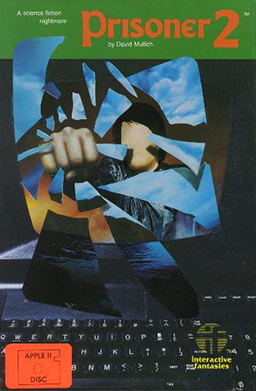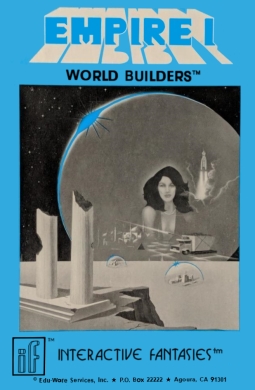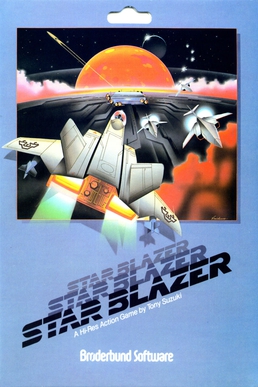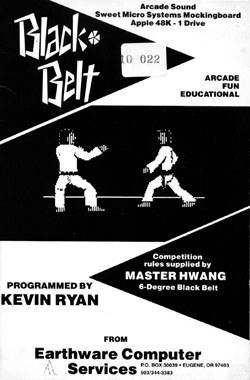
Zork is a text adventure game first released in 1977 by developers Tim Anderson, Marc Blank, Bruce Daniels, and Dave Lebling for the PDP-10 mainframe computer. The original developers and others, as the company Infocom, expanded and split the game into three titles—Zork I: The Great Underground Empire, Zork II: The Wizard of Frobozz, and Zork III: The Dungeon Master—which were released commercially for a range of personal computers beginning in 1980. In Zork, the player explores the abandoned Great Underground Empire in search of treasure. The player moves between the game's hundreds of locations and interacts with objects by typing commands in natural language that the game interprets. The program acts as a narrator, describing the player's location and the results of the player's commands. It has been described as the most famous piece of interactive fiction.
Wizardry is a series of role-playing video games, developed by Sir-Tech, that were highly influential in the evolution of modern role-playing video games. The original Wizardry was a significant influence on early console role-playing games such as Final Fantasy and Dragon Quest. Originally made for the Apple II, the games were later ported to other platforms. The last game in the original series by Sir-Tech was Wizardry 8, released in 2001. There have since been various spin-off titles developed for the Japanese market.

Reach for the Stars is a science fiction strategy video game. It is the earliest known commercially published example of the 4X genre. It was written by Roger Keating and Ian Trout of SSG of Australia and published in 1983 for the Commodore 64 and then the Apple II in 1985. Versions for Mac OS, Amiga, Apple IIGS, and DOS were released in 1988.
Edu-Ware Services, Inc. was an educational and entertainment software publisher established in 1979 by Sherwin Steffin and Steven Pederson. It was known for its adventure games, role-playing video games, and flight simulators for the Apple II series of computers.

David Mullich is an American game producer and designer. He created the 1980 adventure game The Prisoner, produced the 1995 adaptation I Have No Mouth, and I Must Scream, and developed Heroes of Might and Magic III and Heroes of Might and Magic IV.

Super Invader is a fixed shooter video game written by Japanese programmer M. Hata for the Apple II and published by Creative Computing Software in November 1979. Super Invader is a clone of Space Invaders.

The Prisoner 2 is a video game published in 1982 by Edu-Ware. It is a remake of the 1980 game The Prisoner.

Space is a text-based role-playing video game for the Apple II designed by Steven Pederson and Sherwin Steffin of Edu-Ware Services. It was one of the first science fiction RPGs to appear on personal computers. An expansion pack, Space II by David Mullich, was released in the same year.

Sargon III is a computer chess program. It is a sequel to Sargon II.

Rendezvous: A Space Shuttle Simulation, is a space simulator published 1982 by Edu-Ware, and developed by Titan Computer Products and NASA scientist Wesley Huntress.

Picnic Paranoia is an action game written by Russ Segal for both the Atari 8-bit computers and Apple II and published by Synapse Software in 1982. A version for the TI-99/4A was published by Atarisoft in 1983. Although the gameplay is identical, all three versions of the game utilize slightly different graphics.

Adventure in Time is a text adventure written by Paul Berker for the Apple II. It was published in 1981 by Phoenix Software, followed by a version for Atari 8-bit computers in 1983.

Empire I: World Builders is a 1981 video game for the Apple II published by Edu-Ware. It is the first game in the Empire trilogy, followed by Empire II: Interstellar Sharks (1982) and Empire III: Armageddon (1983).

The Queen of Phobos is a graphical text adventure for the Apple II published by American studio Phoenix Software in 1982.

Empire III: Armageddon is a video game for the Apple II published by Edu-Ware in 1983. It is the third game in the Empire trilogy, preceded by Empire I: World Builders (1981) and Empire II: Interstellar Sharks (1982).

Crystal Caverns is a text adventure written by Daniel Kitchen of American studio Imaginative Systems Software for the Apple II and published by Hayden Software in 1982. A Commodore 64 port was released in 1984.

The Final Conflict is a strategy video game written by Thomas G. Cleaver for the Apple II and published by Hayden Software in 1982. A version for Atari 8-bit computers followed in 1983.

Star Blazer is a horizontally scrolling shooter programmed by Tony Suzuki for the Apple II and published by Broderbund Software in 1982. A version for Atari 8-bit computers was released in 1983 as Sky Blazer.

Black Belt is a 1984 video game published by Earthware Computer Services for the Apple II and Commodore 64. A taekwondo simulator, this title allows a player to spar with another human or computer opponent while strictly adhering to the rules of the sport including scoring and penalties. Black Belt is the fourth game from Earthware and the second programmed by Kevin Ryan for the company. The game was released as an educational supplement to real life taekwondo training.

















